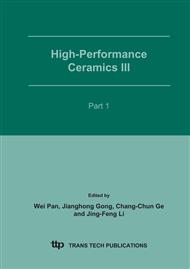p.1559
p.1563
p.1567
p.1571
p.1575
p.1581
p.1585
p.1589
p.1595
Formation of Bone-Like Apatite of Bioceramics Modified by Cold Plasma in SBF and Mechanism of Active Modification
Abstract:
BGC, HA, β-TCP and biphase calcium phosphate (β-TCP/HA) were modified by using the cold plasma technique in the present study. The study results came from the formation of bone-like apatite in SBF and results of osteoblast culture in vitro, SEM, XPS, and XRD. The results showed that the formation of bone-like apatite on bioceramics modified by cold plasma was easier than that of no modification and the growth of osteoblast could be promoted. The active mechanism was that impact on bioceramics by means of the particles with high energy and high activity led to rough and etched surface of bioceramics, as well as the distortion of bioceramics crystal, which increased solubility of materials and local concentration of Ca and P ion. It was helpful for the formation of bone-like apatite. It was showed that the modification using cold plasma technique could increase the activity of bioceramics.
Info:
Periodical:
Pages:
1575-1580
Citation:
Online since:
February 2007
Authors:
Keywords:
Price:
Сopyright:
© 2005 Trans Tech Publications Ltd. All Rights Reserved
Share:
Citation:


